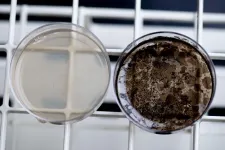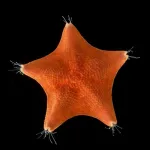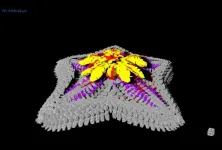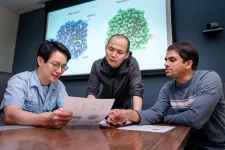(Press-News.org) Optical tweezers manipulate tiny things like cells and nanoparticles using lasers. While they might sound like tractor beams from science fiction, the fact is their development garnered scientists a Nobel Prize in 2018.
Scientists have now used supercomputers to make optical tweezers safer to use on living cells with applications to cancer therapy, environmental monitoring, and more.
“We believe our research is one significant step closer towards the industrialization of optical tweezers in biological applications, specifically in both selective cellular surgery and targeted drug delivery,” said Pavana Kollipara, a recent graduate of The University of Texas at Austin. Kollipara co-authored a study on optical tweezers published August 2023 in Nature Communications, written just before he completed his PhD in mechanical engineering under fellow study co-author Yuebing Zheng of UT Austin, the corresponding author of the paper.
Optical tweezers trap and move small particles because light has momentum, which can transfer to an impacted particle. Intensified light in lasers amps it up.
Kollipara and colleagues took optical tweezers one step further by developing a method to keep the targeted particle cool, using a heat sink and thermoelectric cooler. Their method, called hypothermal optothermophoretic tweezers (HOTTs), can achieve low-power trapping of diverse colloids and biological cells in their native fluids.
This latest advancement could help overcome problems with current laser light tweezers because they scorch the sample too much for biological applications.
“The main idea of this work is simple," Kollipara said. "If the sample is getting damaged because of the heat, just cool the entire thing down, and then heat it with the laser beam. Eventually, when the target such as a biological cell gets trapped, the temperature is still close to the ambient temperature of 27-34 °C. You can trap it at lower laser power and control the temperature, thereby removing photon or thermal damage to the cells.”
The science team tested their HOTT on human red blood cells, which are sensitive to temperature changes.
“Using conventional optical tweezers, the cell structure is damaged and they die immediately. We have demonstrated that, no matter what kind of solution the cells are dispersed in, our technique can safely trap and manipulate them. That was one of the major findings in the study,” Kollipara said.
Another finding applies to drug delivery applications. Plasmonic vesicles, tiny gold nanoparticle-coated bio-containers, were trapped without being reputed moved to different locations inside a solution, analogous to guiding drugs to a targeted cancer tumor. Once they reach the cancer target, they are hit with a secondary laser beam to burst open the drug cargo.
“Laser induced drug delivery is important because we can focus and deliver drugs on a particular target. This way, the amount of drugs a patient consumes goes down significantly, and you can specify at what locations you can administer the drug,” Kollipara added.
Supercomputer simulations were needed to compute full-scale 3D force magnitudes on the particles from the optical, thermalphoretic, and thermoelectric fields achieved at a particular laser power. While a PhD student at UT Austin, Kollipara was awarded allocations on TACC’s Stampede2, a national strategic resource shared by thousands of scientists funded by the National Science Foundation.
“The system is so complex in terms of computational cost requirements that our local workstations cannot support it. We would need to run a simulation for days to achieve just one data point, and we need thousands. TACC has helped us in our analysis and generates results orders of magnitude faster than anything else that we have,” Kollipara said.
More broadly and not directly for this study, Kollipara’s plasmic biosensor research has also used TACC’s Lonestar5 system to run more extensive simulations. Lonestar5, and now Lonestar6 specifically serve scientists in the UT System through the University of Texas Research Cyberinfrastructure (UTRC).
"Building a complicated model alone is not enough," Kollipara said": 'You need to ensure that it is running properly through experimentation. Laptop computers are not sufficient for the needs of hardcore research and development. That’s where supercomputing resources like those at TACC help researchers push research and development as fast as possible and keep up with human needs."
END
New twist on optical tweezers
Stampede2 supercomputer helps guide laser research for cancer therapeutics
2023-11-01
ELSE PRESS RELEASES FROM THIS DATE:
Stigma felt by opioid-dependent moms impacts the health care received by their babies
2023-11-01
COLUMBIA, Mo. -- The rate of opioid use among pregnant women in the United States quadrupled between 1999 and 2014 and continues to rise — an alarming trend that researchers from the University of Missouri and University of Iowa say has exposed the stigma felt by opioid-dependent mothers and how their shame has negatively impacted the health care received by their infants.
Jamie Morton led a study, which was a metasynthesis of existing literature on the topic, as a doctoral student at the MU Sinclair School of Nursing. She said the findings can help ensure health care providers, family ...
The ringed seals in Ilulissat Icefjord, Greenland are special
2023-11-01
Exploring Arctic nature can be difficult. Harsh conditions and great distances are significant challenges when researchers want to coax secrets out of nature.
However, a research project, led by Greenlandic and Danish researchers, has now succeeded in describing a new type of ringed seal that lives in the Icefjord near Ilulissat in West Greenland; a unique natural area on the UNESCO World Heritage List.
The results have just been published in the renowned scientific journal Molecular Ecology.
A small population
Over ...
NRL ISS Mission seeks new bioinspired materials
2023-11-01
WASHINGTON – The U.S. Naval Research Laboratory’s Melanized Microbes for Multiple Uses in Space Project, or MELSP, will use the International Space Station (ISS) to search for production of melanin variants and other useful biomaterials that can have applications both on Earth and in space. The mission is scheduled to launch in early November 2023.
Melanin is described as a group of biopolymers responsible for various biological functions, including pigmentation of skin, hair, and iris of the eyes, which helps protect body ...
Pinpointing HIV immune response
2023-11-01
New research combining computer modeling and experiments with macaques shows the body’s immune system helps control human immunodeficiency virus (HIV) infections largely by suppressing viral production in already infected cells while also killing viral infected cells, but only within a narrow time window at the start of a cell’s infection.
“To eliminate HIV, we have to understand how the immune system attempts to control the infection,” said Ruy M. Ribeiro, a theoretical biologist at Los Alamos National Laboratory who led the development of the model ...
First mice engineered to survive COVID-19 like young, healthy humans
2023-11-01
Researchers have genetically engineered the first mice that get a human-like form of COVID-19, according to a study published online November 1 in Nature.
Led by researchers from NYU Grossman School of Medicine, the new work created lab mice with human genetic material for ACE2 – a protein snagged by the pandemic virus so it can attach to human cells as part of the infection. The mice with this genetic change developed symptoms similar to young humans infected with the virus causing COVID-19, instead of dying ...
As people live longer, family caregivers face financial challenges
2023-11-01
PHILADELPHIA (November 1, 2023) – Many people overlook the short- and long-term costs of financial caregiving, a growing problem that financial advisors and employers can help address, according to a new report by the TIAA Institute and the University of Pennsylvania School of Nursing (Penn Nursing).
One in five adults now provide uncompensated care to loved ones with health problems, and the report provides a comprehensive compilation of insights and research that underscores how the caregivers face a ...
Human mini guts reveal new insights into the process leading to Cronkhite-Canada syndrome and potential new therapies
2023-11-01
Researchers at Baylor College of Medicine and collaborating institutions working with human intestinal organoids, also called mini guts, have shed new light on the potential causes of Cronkhite-Canada syndrome, a rare condition characterized by abundant non-cancerous growths or polyps in the intestine and other symptoms such as hair and nail loss and changes in skin pigmentation. Published in The Journal of Clinical Investigation, the study is the first to show a connection between high polyp proliferation and increased levels of serotonin produced by the intestinal epithelium.
The findings suggest a potential new approach to treat this disease with serotonin ...
Long presumed to have no heads at all, sea stars may be nothing but
2023-11-01
For centuries, naturalists have puzzled over what might constitute the head of a sea star, commonly called a “starfish.” When looking at a worm, or a fish, it’s clear which end is the head and which is the tail. But with their five identical arms — any of which can take the lead in propelling sea stars across the seabed — it’s been anybody’s guess how to determine the front end of the organism from the back. This unusual body plan has led many to conclude that sea stars perhaps don’t have a head at all.
But ...
Starfish body is a head, say scientists
2023-11-01
EMBARGOED: Not for Release Until 01 November 2023 at 16:00 (London time)
The bodies of starfish and other echinoderms are more like heads, according to new research involving the University of Southampton.
The research, published today [1 November] in Nature, helps to answer the mystery of how these creatures evolved their distinctive star-shaped body, which has long puzzled scientists.
Echinoderms are a group of animals that includes starfish (or sea stars), sea urchins, and sand dollars. They have a unique ‘fivefold symmetric’ body plan, which means ...
Scientists reveal structures of neurotransmitter transporter
2023-11-01
(Memphis, Tenn – November 1, 2023) Neurons talk to each other using chemical signals called neurotransmitters. Scientists at St. Jude Children’s Research Hospital have drawn on structural biology expertise to determine structures of vesicular monoamine transporter 2 (VMAT2), a key component of neuronal communication. By visualizing VMAT2 in different states, scientists now better understand how it functions and how the different shapes the protein takes influence drug binding — critical information for ...
LAST 30 PRESS RELEASES:
Why nail-biting, procrastination and other self-sabotaging behaviors are rooted in survival instincts
Regional variations in mechanical properties of porcine leptomeninges
Artificial empathy in therapy and healthcare: advancements in interpersonal interaction technologies
Why some brains switch gears more efficiently than others
UVA’s Jundong Li wins ICDM’S 2025 Tao Li Award for data mining, machine learning
UVA’s low-power, high-performance computer power player Mircea Stan earns National Academy of Inventors fellowship
Not playing by the rules: USU researcher explores filamentous algae dynamics in rivers
Do our body clocks influence our risk of dementia?
Anthropologists offer new evidence of bipedalism in long-debated fossil discovery
Safer receipt paper from wood
Dosage-sensitive genes suggest no whole-genome duplications in ancestral angiosperm
First ancient human herpesvirus genomes document their deep history with humans
Why Some Bacteria Survive Antibiotics and How to Stop Them - New study reveals that bacteria can survive antibiotic treatment through two fundamentally different “shutdown modes”
UCLA study links scar healing to dangerous placenta condition
CHANGE-seq-BE finds off-target changes in the genome from base editors
The Journal of Nuclear Medicine Ahead-of-Print Tip Sheet: January 2, 2026
Delayed or absent first dose of measles, mumps, and rubella vaccination
Trends in US preterm birth rates by household income and race and ethnicity
Study identifies potential biomarker linked to progression and brain inflammation in multiple sclerosis
Many mothers in Norway do not show up for postnatal check-ups
Researchers want to find out why quick clay is so unstable
Superradiant spins show teamwork at the quantum scale
Cleveland Clinic Research links tumor bacteria to immunotherapy resistance in head and neck cancer
First Editorial of 2026: Resisting AI slop
Joint ground- and space-based observations reveal Saturn-mass rogue planet
Inheritable genetic variant offers protection against blood cancer risk and progression
Pigs settled Pacific islands alongside early human voyagers
A Coral reef’s daily pulse reshapes microbes in surrounding waters
EAST Tokamak experiments exceed plasma density limit, offering new approach to fusion ignition
Groundbreaking discovery reveals Africa’s oldest cremation pyre and complex ritual practices
[Press-News.org] New twist on optical tweezersStampede2 supercomputer helps guide laser research for cancer therapeutics







